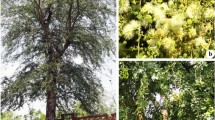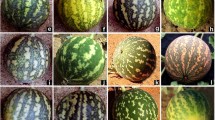Abstract
Jatropha curcas L. (Euphorbiaceae) has acquired a great importance as a renewable source of energy with a number of environmental benefits. Very few attempts were made to understand the extent of genetic diversity of J. curcas germplasm. In the present study, efforts were made to analyze the genetic diversity among the elite germplasms of J. curcas, selected on the basis of their performance in field using random amplified polymorphic DNA (RAPD), amplified fragment length polymorphism (AFLP) and simple sequence repeats (SSR). The plants were selected on the basis of height, canopy circumference, number of seeds per fruit, weight of 100 seeds, seed yield in grams per plant and oil content. Out of 250 RAPD (with 26 primers), 822 AFLP (with 17 primers) and 19 SSR band classes, 141, 346 and 7 were found to be polymorphic, respectively. The percentage polymorphism among the selected germplasms using RAPD, AFLP and SSR was found to be 56.43, 57.9, and 36.84, respectively. The Jaccard’s similarity coefficient was found 0.91, 0.90 and 0.91 through RAPD, AFLP and SSR marker systems, respectively. Principle component analysis (PCA) and dendrogarm analysis of genetic relationship among the germplasm using RAPD, AFLP and SSR data showed a good correlation for individual markers. The germplasm JCC-11, 12, 13, 14 and 15 whose yield found to be high were clustered together in dendrogram and PCA analysis though JCC11 is geographically distinct from others. In overall analysis JCC6 (in RAPD), JCC8 (in AFLP) and JCC 6 and JCC10 (in SSR) were found genetically diverse. Characterization of geographically distinct and genetically diverse germplasms with varied yield characters is an important step in marker assisted selection (MAS) and it can be useful for breeding programs and QTL mapping.









Similar content being viewed by others
References
Mandpe S, Kadlaskar S, Degen W, Keppeler S (2005) On road testing of advanced common rail diesel vehicles with biodiesel from the Jatropha curcas plant. Soc Automot Eng Int 26:356–364
Ginwal HS, Phartyal SS, Rawat PS, Srivastava RL (2005) Seed source variation in morphology, germination and seedling growth of Jatropha crucas Linn. in Central India. Silvae Genet 54(2):76–80
Basha SD, Sujatha M (2007) Inter and intra-population variability of J. curcas (L.) characterized by RAPD and ISSR markers and development of population-specific SCAR markers. Euphytica 56:375–386
Sudheer DVN, Mastan SG, Rahman H, Reddy MP (2010) Molecular characterization and genetic diversity analysis of Jatropha curcas L. in India using RAPD and AFLP analysis. Mol Biol Rep 37:2249–2257
Sudheer PDVN, Sarkar R, Meenakshi, Boricha G, Reddy MP (2009) A simple protocol for isolation of high quality genomic DNA from Jatropha curcas for genetic diversity and molecular marker studies. Indian J Biotechnol 8:187–192
Williams JG, Kubelik AR, Livak J, Rafalski J, Tingey SV (1990) DNA polymorphism amplified by arbitrary primers are useful as genetic markers. Nucleic Acid Res 18:6531–6535
Vos P, Hogers R, Bleeker M, Reijans M, de Lee V, Miranda T, Hornes FA, Pot J, Peleman J, Kuiper M, Zabeau M (1995) AFLP: a new technique for DNA fingerprinting. Nucleic Acid Res 23:4407–4414
Jaccard P (1908) Nouvelles recherché sur la distribution florale. Bull Soc Vaud Sci Nat 44:223–270
Rohlf FJ (2001) Numerical taxonomy and multivariate analysis system. Applied Biostatistics, New York
Nei M, Li WH (1979) Mathematical model for studying genetic variation in terms of restriction end nucleases. Proc Natl Acad Sci USA 76:5269–5273
Felsenstein J (1985) Confidence limits on phylogenies: an approach using the bootstrap. Evolution 39:783–791
Sudheer PDVN, Rahman H, Mastan SG, Reddy MP (2010) Isolation of novel microsatellites using FIASCO by dual probe enrichment from Jatropha curcas L. and study on genetic equilibrium and diversity of Indian population revealed by isolated microsatellites. Mol Biol Rep 37:3785–3793
Sun QB, Lin-Feng L, Yong L, Guo-Jiang W, Xue-Jun G (2008) SSR and AFLP markers reveal low genetic diversity in the biofuel plant Jatropha curcas in China. Crop Sci 48:1865–1871
Èesonienë L, Daubaras R, Gelvonauskis B (2005) Characterization of kolomikta kiwi (Actinidia kolomikta) genetic diversity by RAPD fingerprinting. Biol Nr 3:1–5
Nuel G, Baril C, Robin S (2001) Varietal distinctness assisted by molecular markers: a methodological approach. Acta Hortic 546:65–71
Huang H, Wang S, Jiang Z, Zhang Z, Gong J (2003) Exploration of Actinidia genetic resources and development of kiwifruit industry in China. Acta Hortic 610:29–43
Sudheer PDVN, Singh S, Mastan SG, Patel J, Reddy MP (2009) Molecular characterization and identification of markers for toxic and non-toxic varieties of Jatropha curcas L. using RAPD, AFLP and SSR markers. Mol Biol Rep 36:1357–1364
Tatikoda L, Suhas PW, Seetha K, Naresh B, Thakur KS, David AH, Prathibha D, Rajeev KV (2008) AFLP-based molecular characterization of an elite germplasm collection of Jatropha curcas L, a biofuel plant. Plant Sci 176(4):505–513
Staub JE, Danin-Poleg Y, Fazio G, Horejsi T, Reis N, Katzir N (2000) Comparative analysis of cultivated melon groups (Cucumis melo L.) using random amplified polymorphic DNA and simple sequence repeat markers. Euphytica 115:225–241
Belaj A, Satovic Z, Cipriani G, Baldoni L, Testolin R, Rallo L, Trujillo I (2003) Comparative study of the discriminating capacity of RAPD, AFLP and SSR markers and of their effectiveness in establishing genetic relationships in olive. Theor Appl Genet 107:736–744
Acknowledgments
The authors wish to thank Council for Scientific and Industrial Research (CSIR), New Delhi, India for financial support.
Author information
Authors and Affiliations
Corresponding author
Electronic supplementary material
Below is the link to the electronic supplementary material.
Rights and permissions
About this article
Cite this article
Mastan, S.G., Sudheer, P.D.V.N., Rahman, H. et al. Molecular characterization of intra-population variability of Jatropha curcas L. using DNA based molecular markers. Mol Biol Rep 39, 4383–4390 (2012). https://doi.org/10.1007/s11033-011-1226-z
Received:
Accepted:
Published:
Issue Date:
DOI: https://doi.org/10.1007/s11033-011-1226-z




